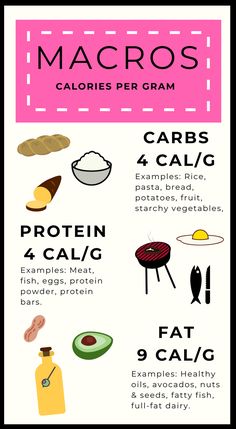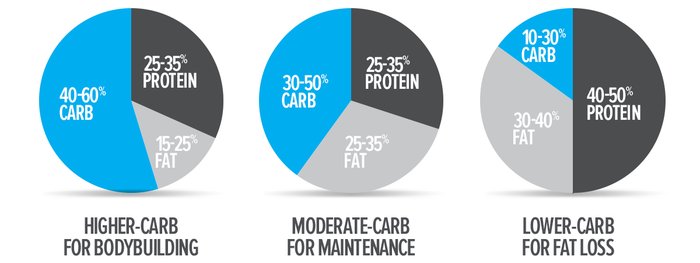How Counting Your Macros, Not Just Calories, Can Tip The Scale

One of the biggest issues with fad diets is that they tend to favor one macronutrient and restrict the others. Enter the Macro Diet. Many people have had success maintaining results long-term, since it’s balanced and not too restrictive. Counting macros not only shows you what the right balance of food looks like for health and performance, but it can also serve as a great way to shift your eating habits and create a sustainable transformation. It gives you wiggle room for eating out with friends, or going out for lunch meetings at work (#irl dieting goals).
So let’s get started with a Macro Diet 101: Macronutrients are the three nutrients your body uses to produce, and store, energy, including energy for exercise! The three macronutrients also happen to be those you’re most likely already familiar with: protein, fat, and carbohydrate.
Each macronutrient contains energy, which is commonly measured in calories.
- Protein has 4 calories per gram.
- Carbohydrate has 4 calories per gram.
- Fat has 9 calories per gram.
So when you count your macros, you are technically controlling your calories, too. But the same isn’t true in reverse. When you’re counting calories, you’re not necessarily finding a balance of all the macronutrients your body needs—and that is what sets this approach apart.

As a general starting point, start out eating about 1 gram of protein per pound of body weight if you exercise regularly (hello barre babes!), then using a handy macro counting guide to figure out a good ratio of fats and carbs for your body and your goals. It may take some trial and error, and that’s normal. Remember this isn’t a one-size-fits-all approach. We like that the above guide factors in 1) your activity level and 2) how you generally gain weight.
With a macro diet, you’re not meant to be depriving your body; you’re meant to be feeding it ideal nutrition that makes it more efficient. Let’s cover some meal inspiration around the 3 primary macronutrients!
Macronutrient #1: Carbohydrates
Fill your plate with healthy carbs, including leafy greens, whole grains and root veggies. A few good picks: broccoli, asparagus, cauliflower, squash, dark leafy greens, green beans, onions, cucumbers, oatmeal, sweet potatoes, potatoes and quinoa.
Macronutrient #2: Protein
You need plenty of protein, but remember all protein isn’t created equal. Choose fatty fish (salmon, mackerel, herring), cod, lean grass-fed beef, turkey, eggs and nuts.
Macronutrient #3: Fat
Getting plenty of healthy fats is important for healthy hormone levels, metabolism, mood, and even vitamin absorption. Foods high in essential fatty acids include: coconut oil, olive oil, avocado, almonds, brazil nuts and macadamia nuts.

Counting your macros is actually very simple, but that doesn’t mean it is easy. Luckily, the app and website, MyFitnessPal, does most of the work for you. Use the app as a food journal to track one week of normal eating (clearly if you know you’re going to have a busy week and will be eating out a lot, or traveling, that’s not your week to try this). Next, review your habits and identify where you struggle, and can make improvements. Do you tend to under-eat in protein? Swap out your snacks with protein-rich foods (*be mindful most protein bars sneak in lots of unnecessary carbs in the form of sugars, and saturated fats! Think lean beef jerky, hard-boiled eggs, or cottage cheese or greek yogurt). Tend to sneak in too much fat? Maybe reduce those two tablespoons of almond butter you slather on your apple to just one; or try using 1/3 instead of 1/2 of an avocado on your morning toast.
If your head is already spinning from all this tracking, we got your covered with some simple nutrition tips, by simply listening to your body’s cues:
- If you’re hungry, add more protein, as it is the most satiating nutrient. More fiber is also filling.
- If you’re tired, add more fibrous veggies to ensure sufficient energy from carbs.
- If you’re not losing weight, lower your carbohydrate intake, especially with dinner.
- If you have sugar cravings, balance your blood sugar better with more protein and fiber and remove all sugar.
- If you are losing weight too fast, add 5 to 6 bites of starch, such as sweet potato, oatmeal or squash, with one meal per day.
- If you are losing muscle mass, add more protein—ideally, an extra 5 to 6 bites of protein per day—and add strength training to your workouts.
Using macro counting to maintain a healthy weight is a good idea—this diet plan will keep you on track, choosing healthy, well-balanced meals, and keep you from feeling starved or having low energy. The great thing about this approach is you don’t need to stress yourself out with exact measurements, or feel guilt if you have a meal that doesn’t completely meet your macros. You can make up for it with your next meal, or the next day’s meals!


